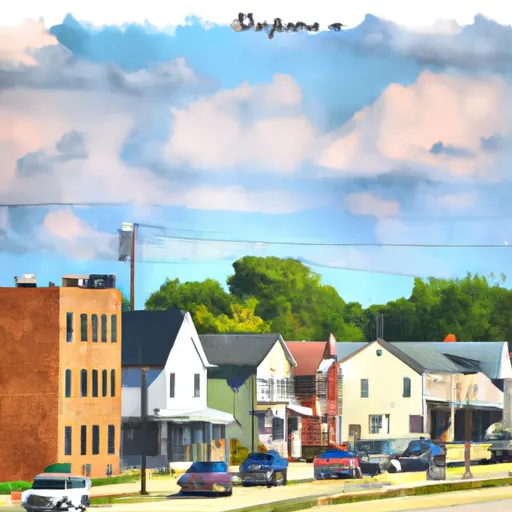-
 Snoflo Premium
Snoflo Premium
Get unlimited access to all our content
With no Ad interruptions! - Start Your Free Trial Login with existing account
Siberia
Eden Index
Climate
8.1
•
Recreation
7.5
•
Community
•
Safeguard
5.8/10

Siberia, Indiana is a small rural community located in Perry County, in the southern part of the state. The town experiences a humid continental climate, characterized by hot, humid summers and cold winters. Average temperatures range from around 20°F (-6°C) in winter to 85°F (29°C) in summer. Precipitation is evenly distributed throughout the year, with an annual average of approximately 44 inches (112 cm).
Hydrologically, Siberia is surrounded by several bodies of water. The Ohio River lies to the west, providing opportunities for boating, fishing, and water sports. Additionally, Siberia Lake and Celina Lake, located nearby, offer excellent fishing and boating opportunities for residents and visitors.
As for outdoor recreation, Siberia is a haven for nature lovers. Hoosier National Forest, situated to the north, provides a picturesque environment for hiking, camping, and wildlife observation. The area is also home to several state parks, including Lincoln State Park and Patoka Lake, offering various outdoor activities such as swimming, picnicking, horseback riding, and hunting.
Overall, Siberia, Indiana offers a diverse climate, abundant water resources, and a range of outdoor recreational opportunities, making it an appealing destination for nature enthusiasts throughout the year.
What is the Eden Index?
The Snoflo Eden Index serves as a comprehensive rating system for regions, evaluating their desirability through a holistic assessment of climate health, outdoor recreation opportunities, and natural disaster risk, acknowledging the profound impact of these factors on livability and well-being.
Climate Health Indicator (CHI): 8.1
Siberia receives approximately
1221mm of rain per year,
with humidity levels near 85%
and air temperatures averaging around
13°C.
Siberia has a plant hardyness factor of
6, meaning
plants and agriculture in this region thrive during a short period during spring and early summer. Most
plants will die off during the colder winter months.
By considering the ideal temperature range, reliable water supplies, clean air, and stable seasonal rain or snowpacks, the Climate Health Indicator (CHI) underscores the significance of a healthy climate as the foundation for quality living.
A healthy climate is paramount for ensuring a high quality of life and livability in a region, fostering both physical well-being and environmental harmony. This can be characterized by ideal temperatures, reliable access to water supplies, clean air, and consistent seasonal rain or snowpacks.
Weather Forecast
Streamflow Conditions
Lower Ohio
Area Rivers
Lower Ohio
Snowpack Depths
Lower Ohio
Reservoir Storage Capacity
Lower Ohio
Groundwater Levels
Recreational Opportunity Index (ROI): 7.5
The Recreational Opportunity Index (ROI) recognizes the value of outdoor recreational options, such as parks, hiking trails, camping sites, and fishing spots, while acknowledging that climate plays a pivotal role in ensuring the comfort and consistency of these experiences.
Access to outdoor recreational opportunities, encompassing activities such as parks, hiking, camping, and fishing, is crucial for overall well-being, and the climate plays a pivotal role in enabling and enhancing these experiences, ensuring that individuals can engage in nature-based activities comfortably and consistently.
Camping Areas
| Campground | Campsites | Reservations | Toilets | Showers | Elevation |
|---|---|---|---|---|---|
| Cedar Creek - Old Hickory Lake | 60 | 459 ft | |||
| Monte Sano State Park | 104 | 1,608 ft | |||
| Henry Horton State Park | 56 | 672 ft | |||
| Ditto Landing City Campground | None | 567 ft | |||
| Poole Knobs - J. Percy Priest Reservoir | 88 | 537 ft | |||
| Seven Points - J. Percy Priest Reservoir | 60 | 521 ft | |||
| Anderson Road - J. Percy Priest Reservoir | 10 | 535 ft | |||
| Easter Posey MWR Military - Redstone Arsenal | None | 569 ft | |||
| Cages Bend - Old Hickory Lake | 43 | 477 ft | |||
| Redstone Arsenal RV Military | None | 637 ft |
Nearby Ski Areas
Catastrophe Safeguard Index (CSI):
The Catastrophe Safeguard Index (CSI) recognizes that natural disaster risk, encompassing floods, fires, hurricanes, and tornadoes, can drastically affect safety and the overall appeal of an area.
The level of natural disaster risk in a region significantly affects safety and the overall livability, with climate change amplifying these risks by potentially increasing the frequency and intensity of events like floods, fires, hurricanes, and tornadoes, thereby posing substantial challenges to community resilience and well-being.
Community Resilience Indicator (CRI):
The Community Resilience Indicator (CRI) recognizes that education, healthcare, and socioeconomics are crucial to the well-being of a region. The CRI acknowledges the profound impact of these elements on residents' overall quality of life. By evaluating educational resources, healthcare accessibility, and economic inclusivity, the index captures the essential aspects that contribute to a thriving community, fostering resident satisfaction, equity, and social cohesion.

